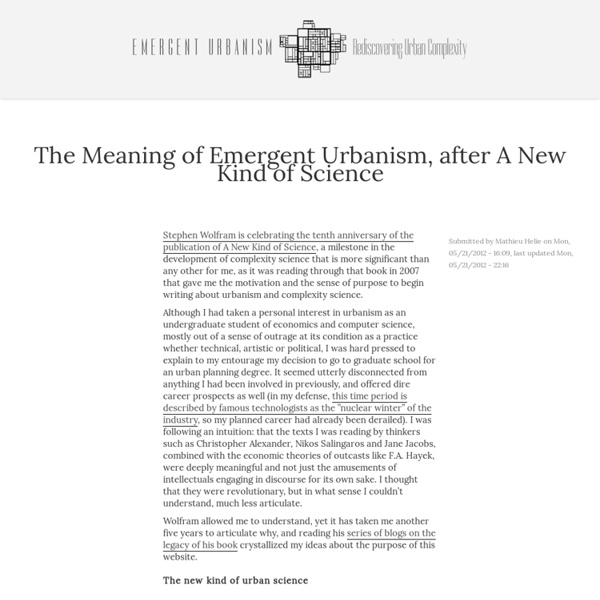The Architect of These Monstrous, Alien Cities Is an Algorithm
Daniel Brown’s photos reveal an alien landscape of concrete canyons, geometric patterns, and dark windows. They bring to mind an enormous spaceship, or a dystopian world. Brown makes his images using generative design software he wrote himself. It creates enormous, complex 3-D patterns that he searches until finding something interesting. The process makes him equal parts magician, explorer, and artist. The London designer and programmer began experimenting with the medium more than a decade ago.
Inception - Cinécourt
Cobb a pour métier de s'introduire dans l'esprit des gens pour y voler leurs secrets. Pour cela, il les endort et manipule leur rêve afin de les placer dans des situations où ils vont révéler "librement" ce qu'ils cachent. Un gros client, qui veut faire main basse sur son concurrent, engage Cobb pour une mission encore plus risquée : non plus voler un secret mais implanter une idée dans le subconscient de la personne, afin qu'au réveil, elle décide de démanteler sa multinationale. Cobb et son équipe préparent ce coup ultime, l'inception, en prévoyant plusieurs niveaux de rêve emboîtés les uns dans les autres...
Introduction
Katarxis Nº 3 Editors' Introduction ‘People used to say that just as the twentieth century had been the century of physics, the twenty-first century would be the century of biology… We would gradually move into a world whose prevailing paradigm was one of complexity, and whose techniques sought the co-adapted harmony of hundreds or thousands of variables. This would, inevitably, involve new technique, new vision, new models of thought, and new models of action. I believe that such a transformation is starting to occur….
Review of The Nature of Order
Katarxis Nº 3 A Review of Alexander's New Magnum Opus, The Nature of Order Michael Mehaffy BIOGRAPHICAL NOTE: Christopher Alexander studied physics and mathematics at Cambridge before earning the first PhD in architecture awarded at Harvard University. Following a distinguished career in architectural research, he was the first recipient ever of the AIA Medal for Architectural Research in 1970. He was honored at that time for his “exceptional willingness to share his scientific findings with the architectural community.”
Contrasting Concepts of Harmony in Architecture
Katarxis Nº 3 Contrasting Concepts of Harmony in Architecture:
The Architecture of “Doctor Strange”
In the ever-expanding genre of comic-book-inspired superhero movies, filmmakers are constantly searching for new ground to cover. For Marvel’s “Doctor Strange,” their latest such effort, that new ground is the realm of mysticism and wizardry, and the primary visual evidence used to demonstrate it is architecture — especially patterning and ornament. Consistently present in built works throughout history and across cultures, pattern is one of the essential elements that makes architecture what it is: ordered space. That the creators of “Doctor Strange” chose its animation to depict the act of bending reality, as practiced by the film’s characters, speaks volumes because it suggests the spatial patterns we cast best symbolize our understanding of reality itself. Via Tumblr († Seven Devils †)
What Inspired Doctor Strange’s Visual Effects? Inception, a Mobile Game, and Black-Light Posters
Spoilers for Doctor Strange below. Opinions about the plot, characterization, and racial politics of Doctor Strange have been mixed, but one point has been more or less unanimous among critics: It’s freaking gorgeous. As we here at Vulture have said, the CGI in Marvel’s latest are among the best of any film in the past 15 years, seamlessly merging human figures with reality-warping landscapes and objects that feel hallucinogenic without looking hokey. Cityscapes fold in on themselves while heroes and villains slide along skyscraper walls; miniature wormholes open up, taking people from one gravitational locus to another.
Michael Hansmeyer - Computational Architecture: Digital Grotesque I
The application of 3D printing technology in architecture has up to now been limited to prototyping or producing small-scale models. Material costs are high, machines have limited scales, and the majority of materials are not strong enough to fulfill construction requirements. Sand-printing technology has recently emerged as an additive manufacturing technique that overcomes these limitations. This technology is currently used primarily to create casting forms in for industrial applications. Yet it has unique features that make it suitable to create architectural components. Specifically, it allows the fabrication of large-scale elements (currently up to 8 cubic meters in size) with high resolution and accuracy at a competitive price and in short period of time.
Introduction to Fractal Geometry
Abstract Fractals is a new branch of mathematics and art. Perhaps this is the reason why most people recognize fractals only as pretty pictures useful as backgrounds on the computer screen or original postcard patterns. But what are they really?
Topological graph theory - Wikipedia
Graphs as topological spaces[edit] Example studies[edit] John Hopcroft and Robert Tarjan[4] derived a means of testing the planarity of a graph in time linear to the number of edges. Their algorithm does this by constructing a graph embedding which they term a "palm tree".
Architects of the complexity
Fractal components in the Gothic and in the Baroque Architecture Professor Nicoletta Sala, Ph-D Accademia di Architettura (Academy of Architecture) di Mendrisio.
The Use of Non-Euclidean Geometry in Art
Euclidean geometry is flat- it is the space we are familiar with- the kind one learns in school. Non-Euclidean geometry is more like curved space, it seems non-intuitive and has different properties. It has found uses in Science such as in describing space-time. It has also been used in art, to lend a more other-wordly, non-conformist feel to the work, especially during the Surrealist movement. I shall delve into the use of such non-Euclidean geometry in art. For the unfamiliar eye, what is non-Euclidean geometry?



